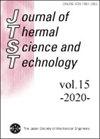恒定入射热通量下太阳能蜂窝高温吸热接收机的共轭模拟
IF 0.9
4区 工程技术
Q3 THERMODYNAMICS
引用次数: 1
摘要
对1000℃及以上高温吸热的碳化硅蜂窝太阳能体积接收器进行了共轭辐射-对流-传导模拟。模拟了三种通道单元尺寸的情况:0.6mm;1.5毫米;2.9毫米。在入射热流密度1,400 kW m和4,200 kW m两个水平上,为了优化工况,对空气质量通量进行了不同程度的改变。当电池尺寸从d = 2.9 mm减小到0.6 mm时,在每个入射热流密度水平上,接收器效率和接收器出口空气温度都有所增加。在1400 kW m时,当空气温度高达1000℃时,在最小电池尺寸d = 0.6 mm的情况下,接收器效率超过0.8。在4200 kW m时,当空气温度接近1500°C时,在d = 0.6 mm的情况下,效率超过0.80。通过能量平衡方程的预算,分析了接收机的热损失。研究发现,减小通道单元尺寸可使热辐射衰减,从而提高接收效率。接收器上边缘的平均温度随通道尺寸的减小而降低,这与热辐射的衰减一致。数值结果表明,缩小电池尺寸对于在超过1000°C或更高的高温下吸收集中的太阳光线是必不可少的。本文章由计算机程序翻译,如有差异,请以英文原文为准。
Conjugate simulation of solar honeycomb receiver for high temperature heat absorption at constant incident heat flux
Conjugate radiation-convection-conduction simulation was conducted for a solar volumetric receiver of silicon carbide honeycomb for high temperature heat absorption at 1,000°C and higher. Simulation was made for three cases of channel cell size: 0.6mm; 1.5mm; 2.9mm. At two levels of incident heat flux 1,400 kW m and 4,200 kW m, air mass flux was changed variously for optimization of working conditions. When the cell size is reduced from d = 2.9 mm to 0.6 mm, the receiver efficiency together with the air temperature at the receiver exit increase at each level of incident heat flux. At 1,400 kW m, the receiver efficiency exceeds 0.8 when the air temperature is as high as 1000°C in the case of the smallest cell size: d = 0.6 mm. At 4,200 kW m , the efficiency surpasses 0.80 when the air temperature is almost 1500°C in the case of d = 0.6 mm. The heat losses from the receiver was analyzed through budget of energy balance equation. It was found that the thermal radiation was attenuated by reduction of channel cell size which resulted in enhancement of the receiver efficiency. The mean temperature at the top edge of the receiver decreased with the reduction of channel size in consistency with the attenuation of thermal radiation. The numerical result demonstrated that the reducing cell size is essential to absorb concentrated solar light at very high temperatures beyond 1000°C and higher.
求助全文
通过发布文献求助,成功后即可免费获取论文全文。
去求助
来源期刊
CiteScore
2.30
自引率
8.30%
发文量
0
审稿时长
5 months
期刊介绍:
JTST covers a variety of fields in thermal engineering including heat and mass transfer, thermodynamics, combustion, bio-heat transfer, micro- and macro-scale transport phenomena and practical thermal problems in industrial applications.

 求助内容:
求助内容: 应助结果提醒方式:
应助结果提醒方式:


